Buzzards Bay is situated between Cape Cod, Southeastern Massachusetts, and the Elizabeth Islands. It is an extensive estuary 28 miles long and about 8 miles in width. But how deep is Buzzards Bay? It is 36 feet deep. The buzzards it was named after were probably ospreys or turkey vultures. Also, it was initially Wampanoag territory and was settled by Europeans in 1621. Additionally, one of its most famous members was the President of the United States, Grover Cleveland, who had a “Summer White House” at Agawam Point in Buzzards Bay. Unfortunately, this home, which was a local landmark, was destroyed on December 10, 1973, by a fire.
Buzzards Bay boasts the National Marine Life Center. This fantastic marine animal hospital, education, and science center rehabilitate stranded dolphins, sea turtles, seals, small whales, and porpoises. Additionally, it also focuses on advancing education and scientific knowledge in marine wildlife conservation and health. Lastly, the Massachusetts Maritime Academy is situated in Buzzards Bay.
About Buzzards Bay
Buzzards Bay’s coastline stretches over 350 miles and offers more than 13 miles of public beaches. These stunning coastlines attract many people from Massachusetts as well as other states. Also, Buzzards Bay can moor more than 12,000 boats during peak times. Furthermore, Buzzards Bay is connected to Cape Cod by Cape Cod Canal, the world’s widest sea-level canal at 480 feet wide. This canal sees more than 20,000 vessels passing through yearly, including container vessels, barges, tugs, cruise ships, and many more. On the East coast, New Bedford Harbor, which is Buzzards Bay’s biggest port, can call itself home to one of the biggest fishing fleets with about 270 vessels.
How Deep is Buzzards Bay?
Buzzards Bay is 36 feet deep, and eleven coastal communities share this bay, including:
- New Bedford
- Westport
- Acushnet
- Dartmouth
- Mattapoisett
- Fairhaven
- Wareham
- Marion
- Gosnold
- Falmouth
- Bourne
Also, the drainage system that services Buzzards Bay is 434 square miles. This bay dates back to the ice age, which was about 15,000 years ago. If you want to visit Buzzards bays in summer, the water temperatures can reach a maximum of 71.6°F. However, the water temperature drops dramatically in winter to around 28 °F. There are many sights and animals to see in and around Buzzards Bay, and we will look at the wildlife that can be spotted.
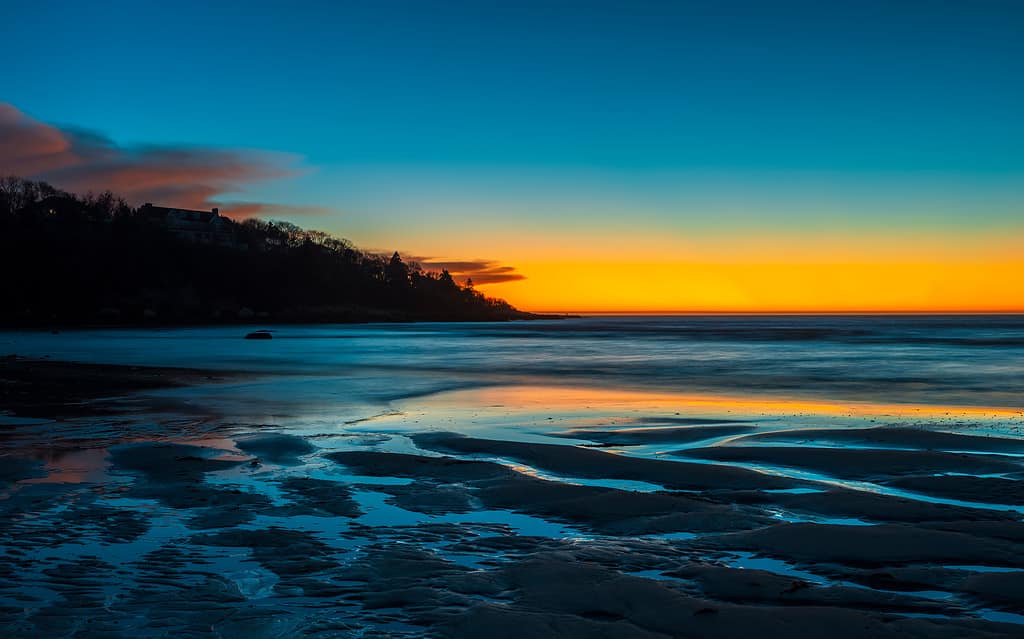
If you want to visit Buzzards bays in summer, the water temperatures can reach a maximum of 71.6°F.
©ayaDadara/Shutterstock.com
American Wigeon
These ducks feed at the water’s surface and do not dive to find food, making them dabbling ducks. Also, American wigeons are known to eat more plant matter than any other species of this kind, as they frequently leave the water to seek food in fields. American wigeons have small black and gray bills. Also, the males have white foreheads, differentiating them from the females. These white foreheads are why this species used to be called “baldpate.” Furthermore, these ducks prefer shallow freshwater wetlands, and they can be found in Sippican Harbor or the Agawam River until April. Afterward, they return to Idaho, North Dakota, and Montana in summer to breed.
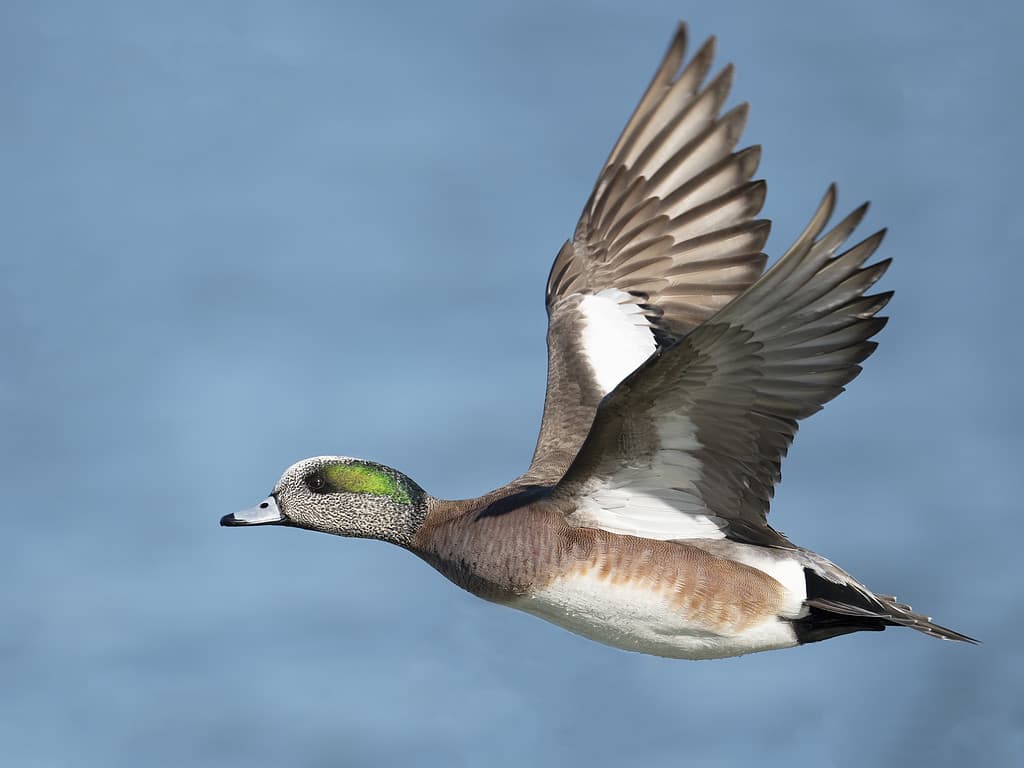
American wigeons are known to eat more plant matter than any other species of this kind, as they frequently leave the water to seek food in fields.
©BrianEKushner/iStock via Getty Images
Common Goldeneye
This duck is named for its striking yellow eyes. However, they actually have gray-brown eyes as hatchlings, which change to purple-blue and blue-green before they change to golden when they are mature. Furthermore, the common goldeneye is known to migrate south much later than other ducks. Therefore, they may not be seen until other species, such as buffleheads, have already been spotted. They occur in Buzzards Bay, West Island, Nasketucket Bay, Gooseberry Island, Wood Hole on Cape Cod, Quissett Harbor, and Great Sippewisset Marsh.

The common goldeneye is known to migrate south much later than other ducks. Therefore, they may not be seen until other species, such as buffleheads, have already been spotted.
©iStock.com/Jeff Huth
Horned Lark
The horned lark is a tiny songbird that stays close to sea level but can live at elevations of up to 13,000 feet. They congregate in large flocks in areas with minimal vegetation and bare ground, like plowed and mowed fields. These little birds have yellow faces with a black mask around their eyes. Also, they have little tufts of black feathers that resemble horns on their heads. They occur in places like the Westport Rivers, the Barney’s Joy area of Dartmouth, and Shaw Farm Trail.
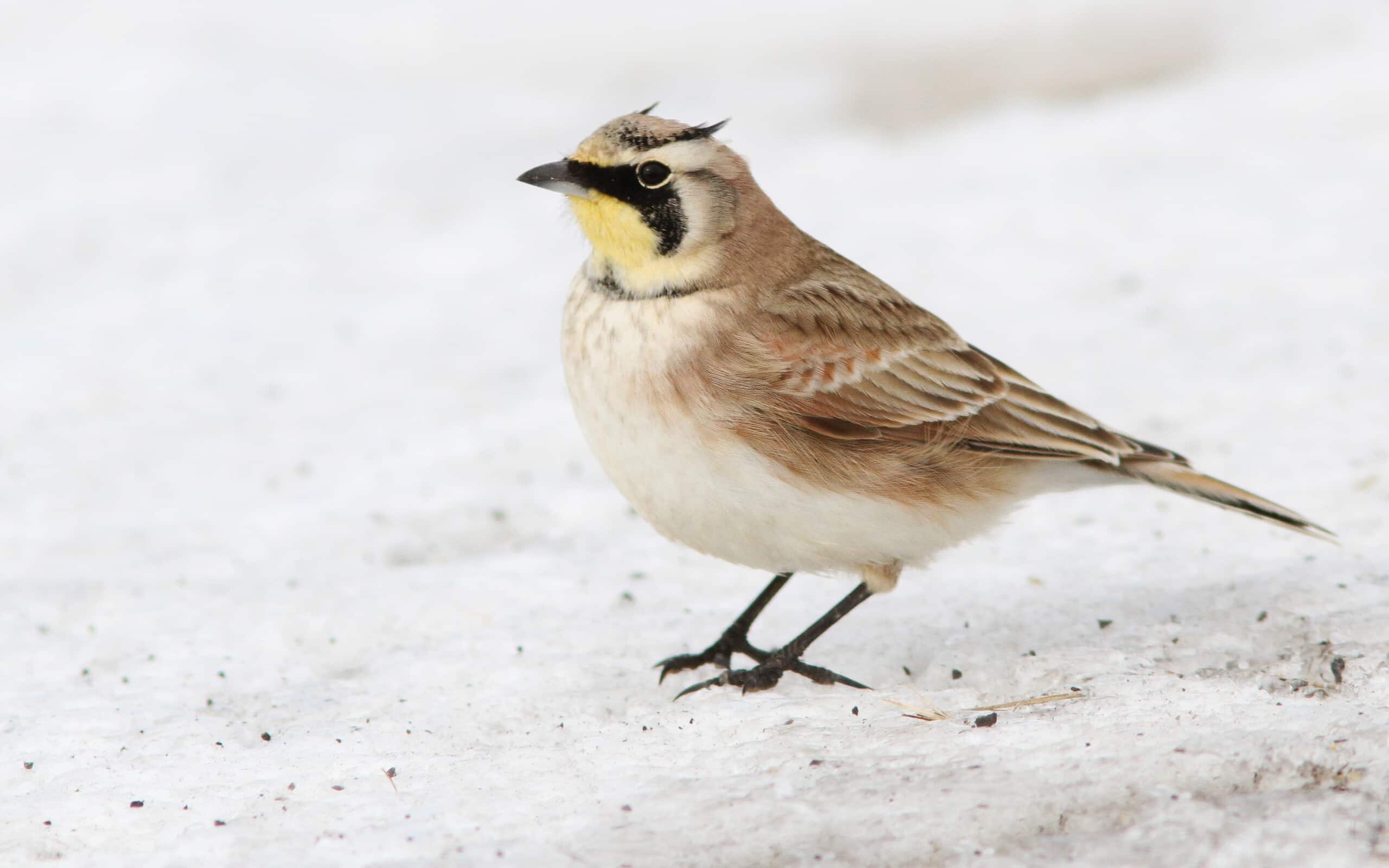
The horned lark is a tiny songbird that stays close to sea level but can live at elevations of up to 13,000 feet.
©mirceax/iStock via Getty Images
Basking Shark
The basking shark is the second biggest shark species in the world, after whale sharks. These enormous sharks can weigh up to 5 tons and measure 32 feet long. These sharks may look frightening. However, they are considered harmless to humans. Basking sharks feed on plankton that they filter through their gills while swimming. Also, they like to visit Buzzards Bay in the summer months. How deep is Buzzards Bay? When people look for these sharks there, they must look in deeper waters rather than close to the coastline.
Sadly, these beautiful sharks are on the vulnerable species list due to overfishing. Therefore, sightings of basking sharks have dramatically decreased in recent years. They are usually grayish-brown or mottled if you are lucky enough to spot one.

The basking shark is the second biggest shark species in the world, after whale sharks. These enormous sharks can weigh up to 5 tons and measure 32 feet long.
©Martin Prochazkacz/Shutterstock.com
Great White Shark
The great white is probably the most legendary of the shark species. These sharks are often spotted in Buzzards Bay. These apex predators will travel lengthy distances to feed here. Therefore, they can be seen quite often during specific months of migration. The great white shark has a bad reputation due to television and movies. However, they are just curious and happen to be very smart. Also, they primarily feed on small marine life, such as fish and seals. Very seldom an attack will occur.
If you plan on being in Buzzards Bay in the summer, look out for these majestic creatures. Even though there are seldom reports of attacks, it would be safer to avoid them. Great white sharks enter the bay to look for seals to eat, and unfortunately, sometimes humans get in the way.

The great white is probably the most legendary of the shark species. These sharks are often spotted in Buzzards Bay.
©Martin Prochazkacz/Shutterstock.com
Smooth Dogfish
The smooth dogfish has stretched cat-like eyes, an asymmetrical notched tail fin, and triangular fins. Additionally, it is unlike most other shark species with sharp teeth. Instead, the smooth dogfish has flat, grinding teeth perfect for chewing and crushing the mollusks and crustaceans they hunt and eat. Also, these sharks are migratory fish that choose the coastal waters of the western Atlantic. Lastly, these sharks are an average of 48 inches long and are not considered a threat to humans.
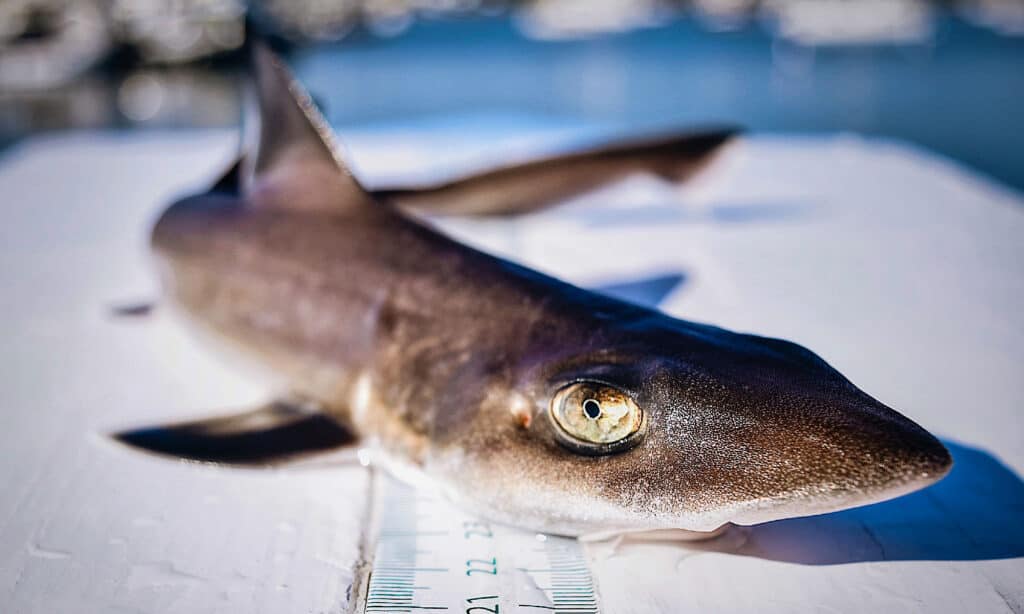
The smooth dogfish has stretched cat-like eyes, an asymmetrical notched tail fin, and triangular fins.
©Rafeed Hussain/Shutterstock.com
Fin Whale
One of the whale species seen in Buzzards Bay is the fin whale. Furthermore, one fin whale, in particular, was spotted about two-thirds of the way from Mattapoisett to Woods Hole. According to photos of the whale, it was about 70 feet long. Also, this whale looked as if it was weakened, as its spine was visible. Because of this weakened condition, it is believed that this whale was in Buzzards Bay to feed on the abundant baitfish found in this area.
Along the United State’s east coast, the waters off Massachusetts provide a substantial feeding area for fin whales. These whales have been known to stay in the waters of Massachusetts for several months. Therefore, the likelihood of spotting them in Buzzards Bay is high. However, these lengthy stays are rare, as they usually only stay for a few days before moving away.
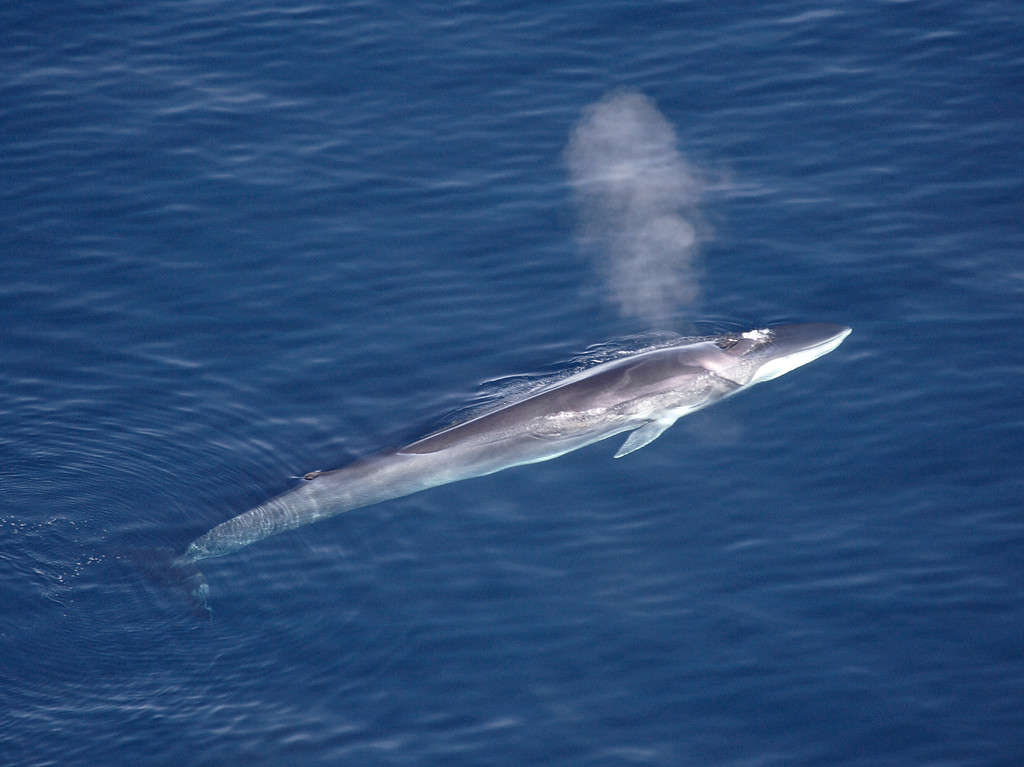
Along the United State’s east coast, the waters off Massachusetts provide a substantial feeding area for fin whales.
©Aqqa Rosing-Asvid – Visit Greenland, CC BY 2.0 – License
Humpback Whale
Massachusetts is known for being able to spot humpback whales. This is due to the whale’s tolerance for whale-watching vessels and their displays of sky-hopping, breaching, and flipper slapping. The best months for spotting whales are May to October, when they are abundant. Also, during these months, you can spot minke, fin, and humpback whales because they all migrate to the seas around Massachusetts for feeding. Humpback whales are unique because they embark on the longest migrations among mammals. Some of these groups of whales can cover 5,000 miles from the areas where they breed and feed.
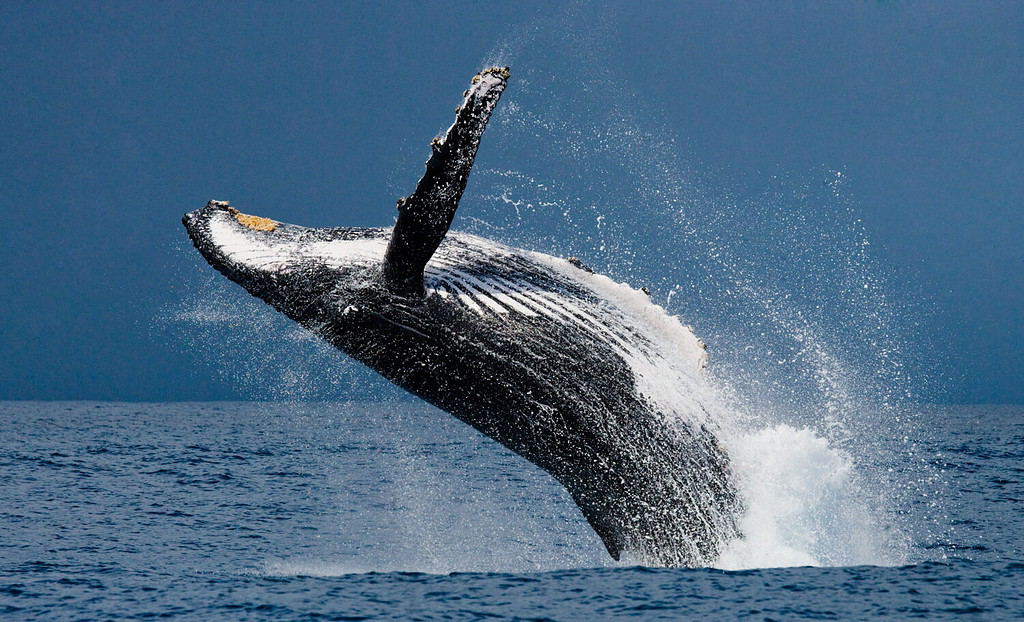
Massachusetts is known for being able to spot humpback whales. This is due to the whale’s tolerance for whale-watching vessels and their displays of sky-hopping, breaching, and flipper slapping.
©GUDKOV ANDREY/Shutterstock.com
Pilot Whale
These whales are known for getting washed ashore on the beaches of Massachusetts and in the waters near Buzzards Bay. Pilot whales can be spotted in the early summer up until fall. Their name comes from the fact that each group of pilot whales has a “pilot” or leader.

These whales are known for getting washed ashore on the beaches of Massachusetts and in the waters near Buzzards Bay.
©Andrew Sutton/Shutterstock.com
The photo featured at the top of this post is © ayaDadara/Shutterstock.com
Thank you for reading! Have some feedback for us? Contact the AZ Animals editorial team.







